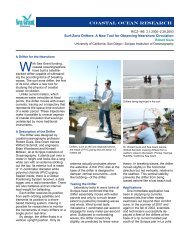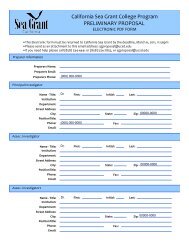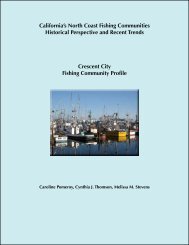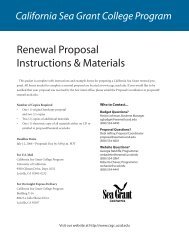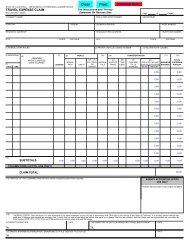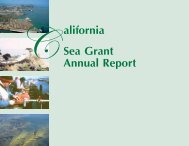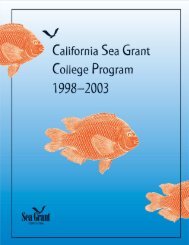California's Central Coast Marine Protected Areas - California Sea ...
California's Central Coast Marine Protected Areas - California Sea ...
California's Central Coast Marine Protected Areas - California Sea ...
Create successful ePaper yourself
Turn your PDF publications into a flip-book with our unique Google optimized e-Paper software.
PISCO divers at a kelp bed at Weston Cove in<br />
the Point Lobos State <strong>Marine</strong> Reserve<br />
Steve Lonhart, NOAA SIMoN<br />
pristine ecosystem that we are only now starting to<br />
explore in depth.”<br />
2. Kelp canopy cover cannot be used reliably to infer<br />
bottom habitat, community structure or otherwise<br />
characterize a site. “We have seen too many cases<br />
where kelp cover is not a good surrogate,” Lonhart<br />
says. “You might see a thick kelp bed at the surface<br />
but the site has relatively few fishes, low invertebrate<br />
cover and few algal species. Similarly, a site with little<br />
kelp cover could have an incredibly rich invertebrate<br />
community and lots of fish.”<br />
Conclusions<br />
This project has led to the collection of a huge amount of<br />
statistically rigorous data on kelp forest fishes, algae and<br />
invertebrates. The data establish the beginnings of a<br />
monitoring program for detecting the effects of the central<br />
coast MPAs on kelp forest ecology. Because of this project,<br />
scientists can now compare kelp forests at the start of the<br />
MPA process. The data may also prove useful in tracking<br />
and modeling ecosystem-level responses to fishing and<br />
climate change.<br />
For detailed information about the survey method visit:<br />
http://www.piscoweb.org/research/community/subtidal/<br />
protocols.<br />
Data Overview<br />
A total of 29 trained divers spent more than 1,200 hours<br />
surveying about 7,520 acres of shallow kelp forest habitat.<br />
They counted (and sized) about 39,000 fish, representing<br />
56 taxa; 71,000 macro invertebrates, representing 41 taxa<br />
and 67,000 canopy-forming kelps, representing nine taxa.<br />
Cooperating Organizations<br />
NOAA’s Monterey Bay National <strong>Marine</strong> Sanctuary<br />
Partnership for Interdisciplinary Studies of <strong>Coast</strong>al<br />
Oceans (PISCO)<br />
Institute for <strong>Marine</strong> Sciences at UC Santa Cruz<br />
Kenneth S. Norris Rancho Marino Reserve of the UC<br />
Natural Reserve System<br />
From the raw data, scientists will be able to compute<br />
site-specific estimates of fish densities, species richness,<br />
relative fish abundances and fish size distributions, as well<br />
as relative densities and percent bottom cover of macro<br />
invertebrates and algae.<br />
Key Observations<br />
1. Kelp forest communities in <strong>Central</strong> <strong>California</strong> are not<br />
uniform, says Steve Lonhart, a biologist and diver at<br />
the Monterey Bay National <strong>Marine</strong> Sanctuary, who<br />
participated in the project. Geology explains some of<br />
the differences. In kelp forests growing on large vertical<br />
pinnacles, rich invertebrate communities dominate the<br />
bottom. In contrast, sandy channels mixed with carsized<br />
boulders and low outcrops create numerous<br />
microhabitats. These prevent dominance by either<br />
invertebrates or macro algae.<br />
Big Sur, for example, provides habitat for several rarely<br />
seen species in Monterey Bay. “Diving along the Big<br />
Sur coast is an entirely different experience,” Lonhart<br />
says. “There is a greater sense of adventure, in part<br />
because of the logistics of diving in such a remote location,<br />
but also because Big Sur represents a relatively<br />
A china rockfish (Sebastes nebulosus) emerges<br />
from a crevice.<br />
Contact:<br />
Mark H. Carr<br />
UC Santa Cruz<br />
Long <strong>Marine</strong> Laboratory<br />
831.459.3958<br />
carr@biology.ucsc.edu<br />
Steve Lonhart, NOAA SIMoN



